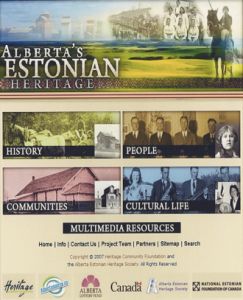Alberta’s Estonian Diaspora
A recent Canada Census indicates that over 2,200 Albertans reported Estonian ethnicity. The first Estonian pioneers arrived here starting in 1899 and soon established several settlements in the central and southern regions of the province of Alberta, established in 1905. Following World War II, several hundred Estonian immigrants also found their way to Alberta and settled largely in Calgary and Edmonton.
Estonian pioneers and later immigrants preserved their cultural heritage by forming societies and organizing traditional events such as Jaanipäev (Midsummer Day) and Christmas celebrations. In fact, the first Estonian Independence Day celebration in Canada was held in Alberta, in 1921, by the Medicine Valley Estonian Society.
After a century of assimilation and changing demographics, a provincewide organization, the Alberta Estonian Heritage Society (AEHS) , was formed in 2005 to provide a focus for heritage activities and events.
The AEHS’s Heritage Project evolved within this framework, ie – the past, the present and the future – and is now complete. Three highly successful centennial celebrations, marking the establishment of Estonian pioneer settlements in Alberta, raised awareness about the fascinating history of Alberta’s Estonian community by bringing together descendants of Estonian pioneers and later immigrants. These celebrations, coupled with a visit by Estonian President Lennart Meri in 2000, provided the impetus to more fully explore the cultural heritage of Alberta’s Estonian community.
The initial phase of the project was captured in a 30-minute documentary DVD entitled “Alberta’s Estonians.” It was presented to audiences at the West Coast Estonian Days in Los Angeles and the EstDocs Film Festival in Toronto in August and October, 2007, respectively.
A major phase of the project involved the publication of a 300-page illustrated book “Freedom, Land & Legacy: Alberta’s Estonians, 1899-2009.” The book tells the story of Alberta’s Estonians from the early pioneer era to present-day activities to preserve their cultural heritage.
Concurrently, the availability of additional historical material, combined with a desire to more fully document the cultural heritage of Alberta’s Estonians, resulted in the development of a website “Alberta’s Estonian Heritage.” The website was designed and produced over several years as additional information became available from descendants of pioneer families, various archives and museums in Canada and Estonia, and other sources.
The website provides a comprehensive record of Alberta’s Estonian community under the headings of History, People, Communities, Cultural Life and Multimedia Resources. It can be accessed at www.aehs.ca, Menu Option “Heritage.”
It provides detailed information about the heritage website, the book, the DVD, and archival materials under the Heritage Project, including information to order the book and the DVD.
All archival materials collected during the six-year Heritage Project have been donated to the Provincial Archives of Alberta (PAA) in Edmonton for storage and preservation in perpetuity. It is known as the “Estonian Collection” and is available to interested researchers and family historians online and onsite. It can be accessed on: www.hermis.alberta.ca/paa. Type “AEHS” in Search box to view file descriptions of Estonian archival materials.
In late 2010, the “Alberta’s Estonian Heritage” website was collected at the request of University of Alberta using“Archive- It” and is part of the Heritage Community Foundation’s Alberta Online Encyclopedia.
The final phase of the AEHS Heritage Project is the “Alberta’s Estonians 1899 to Present” exhibit,” consisting of six large framed panels, nine framed historical photos, and other artifacts which tell the story of Alberta’s Estonian pioneers and immigrants. The exhibit was on display at the PAA and our Jaanipäev (Midsummer) celebration at Gilby Hall during the first half of 2012. As of January 19, 2013, the exhibit has been on display at Tartu College’s Estonian Studies Centre in Toronto, to be followed by a brief appearance in Ottawa tentatively scheduled for May. The exhibit will also be on display at the West Coast Estonian Days/ESTO celebration in San Francisco between June 28 and July 1, 2013.
Many Society members, friends and granting agencies, including the Alberta, Canadian and Estonian governments, Estonian Foundation of Canada, and the Estonian (Toronto) Credit Union contributed to the success of the Heritage Project. We can all take pride in this accomplishment.
For further information  about the Heritage Project go to AEHS website: www.aehs.ca and select Menu Option ‘Heritage.’ The Heritage Option provides detailed information about the deliverables (heritage website, book, DVD, archival materials) under the Heritage Project, including ordering procedures for the book and the DVD, and login addresses for the heritage website and the Estonian Collection at the Provincial Archives of Alberta.
about the Heritage Project go to AEHS website: www.aehs.ca and select Menu Option ‘Heritage.’ The Heritage Option provides detailed information about the deliverables (heritage website, book, DVD, archival materials) under the Heritage Project, including ordering procedures for the book and the DVD, and login addresses for the heritage website and the Estonian Collection at the Provincial Archives of Alberta.
The “Alberta’s Estonian Heritage” website is preserved as part of the University of Alberta’s “Archive It” site and can be accessed directly by logging on to the archival site www.Albertasource.ca/abestonians/. “Alberta’s Estonian Heritage” website was updated at end of 2012.
Description of the Estonian Collection of materials used in the Heritage Project, stored at the Provincial Archives of Alberta in Edmonton, can be accessed on: www.hermis.alberta.ca/paa. Type “AEHS” in Search box to view file descriptions of Estonian archival materials stored at the PAA.
Dave Kiil, Eda McClung